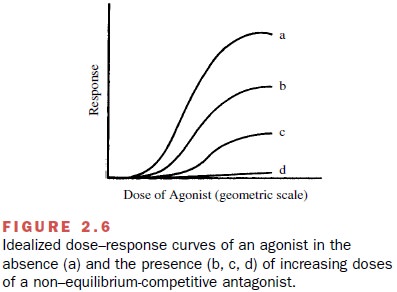Chapter: Modern Pharmacology with Clinical Applications: Mechanisms of Drug Action
Drug Antagonism
DRUG ANTAGONISM
The terms agonist and antagonist have already been in-troduced. The several types of
antagonism can be classi-fied as follows
1.
Chemical antagonism
2.
Functional antagonism
3.
Competitive antagonism
a.
Equilibrium competitive
b.
Nonequilibrium competitive
4.
Noncompetitive antagonism
Chemical Antagonism
Chemical antagonism involves a direct
chemical interac-tion between the agonist and antagonist in such a way as to render the agonist pharmacologically
inactive. A good example is the use of chelating agents to assist in the
biological inactivation and removal from the body of toxic metals. Chelation involves a particular type of
two-pronged attachment of the antagonist to a metal (the agonist). One chemical
chelator, dimercaprol, is used in the treatment of toxicity from mercury,
arsenic, and gold. After complexing with the dimercaprol, mer-cury is
biologically inactive and the complex is excreted in the urine.
Functional Antagonism
Functional antagonism is a term used to represent the interaction of two agonists that act
independently of each other but happen to cause opposite effects. Thus,
indirectly, each tends to cancel out or reduce the effect of the other. A
classic example is acetylcholine and epi-nephrine. These agonists have opposite
effects on sev-eral body functions. Acetylcholine slows the heart, and
epinephrine accelerates it. Acetylcholine stimulates intestinal movement, and
epinephrine inhibits it. Acetylcholine constricts the pupil, and epinephrine
di-lates it; and so on.
Competitive Antagonism
Competitive antagonism is the most frequently encoun-tered type of
drug antagonism in clinical practice. The
antagonist combines with the same site on
the receptor as does the agonist, but unlike the agonist, does not induce a
response; that is, the antagonist has little or no efficacy. The antagonist competes with the agonist for its binding
site on the receptor. Competitive antagonists can fall into either of two
subtypes, depending on the type of bond formed between the antagonist and the
receptor. If the bond is a loose one, the antagonism is called equi-librium competitive or reversibly competitive. If the bond is covalent, however, the
combination of the an-tagonist with the receptor is not readily reversible, and
the antagonism is termed nonequilibrium
competitive or irreversibly
competitive.
If the antagonism is of the equilibrium type, the an-tagonism increases as the concentration of the antago-nist increases. Conversely, the antagonism can be over-come (surmounted) if the concentration of the agonist in the biophase (the region of the receptors) is increased.

This relationship
can best be appreciated by ex-amining dose–response curves, as in Figure 2.5.
Curve a is obtained in the absence of
the antagonist. Curve b is obtained
in the presence of a modest amount of the an-tagonist. The curves are parallel,
and the maximum ef-fects are equal. The antagonist has shifted the dose–
response curve of the agonist to the right. Any level of response is still
possible, but greater amounts of the ag-onist are required. If the amount of
the antagonist is in-creased, the dose–response curve is shifted farther to the
right (curve c), still with no
decrease in the maxi-mum effect of the agonist. However, the amount of ag-onist
required to achieve maximum response is greater with each increase in the
amount of antagonist. Examples of equilibrium-competitive antagonists are
atropine, d-tubocurarine
phentolamine, and naloxone.
Of course, this continual
shift of the curve to the right with no change in maximum as the dose of
antag-onist is increased assumes that very large amounts of the agonist can be
achieved in the biophase. This is gen-erally true when the agonist is a drug
being added from outside the biological system. However, if the agonist is a
naturally occurring substance released from within the biological system (e.g.,
a neurotransmitter), the sup-ply of the agonist may be quite limited. In that
case, in-creasing the amount of antagonist ultimately abolishes all response.
The effect of a
nonequilibrium antagonist on the dose–response curve of an agonist is quite different
from the effect of an equilibrium antagonist, as illus-trated in Figure 2.6. As
the dose of nonequilibrium an-tagonist is increased, the slope of the agonist
curve and the maximum response achieved are progressively de-pressed. When the
amount of antagonist is adequate (curve d),
no amount of agonist can produce any re-sponse. The haloalkylamines, such as
phenoxybenza-mine, which form covalent bonds with receptors, are ex-amples of
nonequilibrium-competitive antagonists .

Noncompetitive Antagonism
In noncompetitive antagonism, the antagonist acts at a site beyond
the receptor for the agonist. The difference between a competitive and a noncompetitive antagonist can be
appreciated from the following scheme, in which two agonists, A and B, interact
with totally different re-ceptor systems, RA and RB, to
initiate a chain of events leading to contraction of a vascular smooth muscle
cell. X is a competitive antagonist, and Y is a noncompetitive antagonist.

Antagonist X (competitive)
has an affinity for RB but not RA. Thus, it specifically
antagonizes agonist B. It does not antagonize agonist A. Antagonist Y acts on a
receptor associated with the cellular translocation of calcium and inhibits the
increase in intracellular free calcium. It will therefore antagonize the
effects of both A and B, since they both ultimately depend on calcium movement
to cause contraction.
The effect of a
noncompetitive antagonist on the dose–response curve for an agonist would be
the same as the effect of a non–equilibrium-competitive antagonist (Fig. 2.6).
The practical difference between a noncompet-itive antagonist and a
nonequilibrium-competitive an-tagonist is specificity.
The noncompetitive antagonist antagonizes agonists acting through more than one
re-ceptor system; the nonequilibrium-competitive antago-nist antagonizes only
agonists acting through one recep-tor system. The antihypertensive drug
diazoxide is one of the few examples of therapeutically useful noncompeti-tive
antagonists .
Related Topics